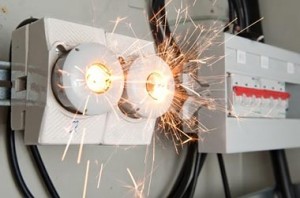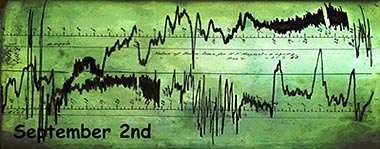Every prepper has his/her own idea of what a major disaster will look like and how likely it is to occur. However, one of the most catastrophic–not to mention scientifically plausible–is the EMP strike, which could be either natural or manmade.
EMP stands for electromagnetic pulse, and occurs in the form of a large burst of electromagnetic radiation that has the potential to disrupt electricity, radio waves, magnetic fields, Wi-Fi, and most other forms of electric currents we use on a daily basis.
The Effects of an EMP
Whether a potential EMP comes in the form of a manmade nuclear attack or a natural solar flare, the effects could be disastrous. Granted, the devastation would largely depend on the strength and severity of the pulse and the location toward which it was geared.
In the worst-case scenario, an EMP could result in a total grid-down scenario and loss of all things electricity.
While this would cause most of mankind to resort to primitive measures of survival not seen since the Dark Ages, certain members of society would fare far worse than others. Among the most at-risk for prolonged survival after an EMP are the elderly, the disabled, and young children and babies.
These individuals often require personalized medical care that involves the use of electronic systems, from diabetes test meters to respiratory aids to heart monitors, the functionality of which are threatened by an EMP.
Protecting Your Essential Electronics
 With so many categories of individual at heightened risk of losing their life-support systems after an EMP strike, its important to have backups of the most essential life-sustaining devices stored in EMP-proof containers for the best chance at long-term.
With so many categories of individual at heightened risk of losing their life-support systems after an EMP strike, its important to have backups of the most essential life-sustaining devices stored in EMP-proof containers for the best chance at long-term.
Again, the effects electronic systems will suffer from an EMP largely depend on its size and altitude. Some solar flares and low-output nuclear bombs may have very little electromagnetic effect on the earth, but precautions should be taken nonetheless.
Essentially, anything that can operate on a charge or on batteries when not plugged into an AC outlet is likely to be spared from an EMP attack. If the device is kept away from other large metal objects and large swaths of wiring, it should remain relatively unharmed and continue to operate as long as its charge or batteries last. Some electronics are inherently EMP-proof, including large electric motors, vacuum tube equipment, electrical generators, transformers and relays, and other large systems often housed in surge-resistant housing.
The Faraday Cage
One survival tool for electronically sensitive equipment is the Faraday cage, a metal box designed to absorb the surge of an EMP without harming its contents. Whatever it is being stored in the Faraday cage must be insulated from the inside metal surface of the box, but should otherwise remain protected. Accordingly, the box should be constructed so that no large gaps or holes are present.
However, many containers are suitable for impromptu Faraday cages including ammunition cases, metal filing cabinets, truck bed cabinets, and the like. Therefore the thickness of the box doesn’t make much difference in determining its effectiveness against EMP waves, though thicker metal is likely to work better overall (think a large safe).
A big myth is that an EMP will wipe out the electronic components of most vehicles. On the contrary, the metal construction of most cars and trucks act as virtual Faraday cages for the electronic components contained within. Therefore, if you were to insulate your vital medical electronics in tin foil, put them in a makeshift Faraday cage, and store it inside your vehicle, it should be protected from most moderate EMP strikes.
Ultimately, it’s all about how you insulate and shield your devices. Thus, a washer or dryer could be used to store some larger or obscurely shaped devices if needed, so long as all sides are made of metal and have a tightly fitting lid.
For most home and commercial electronic devices, surge protectors and lighting arrestors serve to protect the systems from failure in the event of a power outage–fortunately they will also protect them against the effects of an EMP. While a powerful surge could wipe out the grid and shut off electrical services, the devices themselves would not be harmed if plugged into a surge protector. However, they would need to be run on a backup power source in the event of this happening.
For better or worse, since we have yet to experience an EMP strike, its unknown as to how effective surge protectors and resistors will be in a real-world event. In the end, the best way to protect vital electronics, like those medical devices needed to sustain life, is to keep them disconnected from external power sources, away from antennas, and shielded in a well-sealed and insulated Faraday cage.
About EMPs
EMPs are most commonly associated with nuclear blasts, and were first tested under the American nuclear weapons development of the 1940s and 50s.
EMPs occur with all nuclear explosions, though the effects are much more profound with larger magnitude blasts. The earth generally absorbs nuclear attacks close to the ground, like those experienced at Hiroshima and Nagasaki, so the effects of an EMP are confined to the areas affected by the blast and subsequent heat wave. As the size and altitude of a nuclear blast increases, so too do the potential for greater EMP effects.
Thus, an EMP would deliver the most devastating effects to earth if a nuclear weapon exploded in space–or high in the earth’s atmosphere. This would cause the gamma radiation released by the blast to strip electrons from the upper levels of the atmosphere and create electromagnetic radiation levels capable of disrupting most of earth’s electronic systems.
Accordingly, scientists and astronomers have long been studying the effects of the radiation produced by solar flares. As far back as 1859 with the Carrington Event (from August 28 till September 2), the largest geomagnetic storm ever recorded occurred and disabled telegraph systems all across Europe and North America.

A study conducted by Lloyd’s of London and the United States’ Atmospheric and Environmental Research (AER) estimated the results of such a storm would have a $2.6 trillion effect on the world economy.
More recently, a series of solar storms in the 1970s was substantial enough to bring an end to the widespread use of CB radios, in addition to disrupting commercial radio and television transmissions.
Like any disaster, there’s no way of knowing the true effects of an EMP until it actually happens. Ideally, we will never know what that experience is like, as it could mean utter devastation for most of mankind in its worse form.
For those dealing with life-threatening medical issues, losing access to electricity may be a life and death scenario. Most evidence suggests the likelihood of a worst-case scenario is slim, but if your life depends on it you should take the necessary precautions.
CLICK HERE to find out more about the effects of an EMP and how to protect your devices.
This article has been written by Cody Griffin for Survivopedia.










































































“Thus, a washer or dryer could be used to store some larger or obscurely shaped devices if needed, so long as all sides are made of metal and have a tightly fitting lid.”
Wouldn’t the cord have to be unplugged to afford protection?
A trash can lined with card board will work also.
It is worth noting that after the 1859 solar storm event, light bulbs exploded and fires were started in homes. Even though things that are plugged in and turned off, there is still one leg of the switch that is connected to the circuit and that makes them vulnerable. The pulse travels so fast, in milliseconds, that it could do damage before a surge protector would trip.
The testing on cars and trucks in regards to EMP were done as levels in the 25kv to 30kv range and some vehicles survived. But any event that we might experience would most likely be in the 100kv to 200kv range.
Because of the insufficient amount of hard data, scientists have tried to do mathematical calculations about the strength and effects of the different components of the EMP. There has never been any clear consensus about whose calculations are correct. Since more testing cannot be done, there is no way to test the accuracy of the calculations made by various scientists since 1962
Well said. Is it possible that an underground bunker help? What are the requirements for this? Your insights may well help. Regards.
Surge protectors operate in nanoseconds. Most surges occur in microseconds so a few milliseconds is unrealistic. A lightening bolt striking close to any wiring emits a field. The MOV’s have impressive respinse times so it’s all in the technology you buy
The aftermath of a huge EMP would indeed be a devastation…however, “dark ages”? I don’t think so. Man had gone through huge plagues, and natural catastrophies, wars and the like. But…we would rally…though crippled…we would rebuild. It might even be to our benefit to put us back into remembrance as to who is in charge of this universe….and it ain’t MAN…you get my meaning? Please note…”In the beginning, God created the heavens and the earth.”(Genesis 1:1)
And the same God who made the heavens and the earth, created man with soul and an intellect and charged him to take care of His earth and have dominion over it.
you might want to look at the Texas situation right now—no food—no water and most of those people have no idesa how to survive except take it from some one else—there would be so much killing and injuries—and no medical help—the government would take care of it self first and the hell with you—-it would be every man for him self to protect his family and property to survive—-arm your self God is.t on the cornor giveing out food————-
See India China blackout wars. See US troops attacked in Syria with energy weapon. See Dr Peter Vincent Pry.
a microwave should make a good Faraday cage too, but if it a working one besure to keep it unpluged when something you want to protect is in it.
Critical point left out: the items stored in ammo cans or METAL garbage cans MUST be insulated from the container, or it is useless.
also, naturally occurring EMP is not often a single event, so you store your items EMP occurs (it is not seen, felt, or heard) indications would look like power surges, and possibly unprotected electronics would not work, so you break out your shielded items, and oops there goes another solar flare, poof there goes your “safe” items, it’s a crap shoot, I still would rather try my luck, But I would only have items out of shielding when I am using them.
Buy an older tube radio that can receive short wave and regular AM broadcasts,
such as a Hallicrafters or Hammarlund.
Would a small home generator sitting in a garage be protected?
No it’s wouldn’t any electrical component would be destroyed, kinda like how your car would be useless because of the electrical components.
Question: you say within your “…EMP Attack” article that vehicles could be considered as a good faraday cage, due to vehicles being made of metal and so on. But vehicles have several windows, so how does glass work in protecting OR not protecting your electronic devises in a real EMP attack?
I like to protect my home.
I have an Idea for protection from EMP the puls is like any wave and will follow the path of least resistance it travels to ground as its final destination. if ground then is all around it should follow it and not seek another path. My idea is to make ground the area that surrounds you the best conductor for this wave. to do this would require the best environment for the wave to follow and the largest path so it will not break down under the stress of any induced currents. to do this we would need a metallic substance that would have the consistency from powder to small flakes. the different sizes would provide for the different frequencies found in a natural EMP coming from the sun event. the earth would be pulverized and then mixed with the metal. the cheapest would be iron and because it exists naturally in earth no pollution would result. mixing it well and then putting it in a rammed earth wall and ceiling should provide maximum protection. because these waves only travel in straight lines the only concern would be the reflected type providing the entrance with angles that would prevent reflected waves from entering any people or equipment should be protected. this structure could be as large as needed to provide protection . I made a small scale model and had some High quality radios inside and it blocked the signals entirely. as always one never assumes that anything works. if other people have tried something like this I would like to know the results and the dimensions used. I have tried other Faraday cages with poor results. opinions please!
Grampa
Sounds like an interesting idea, grandpa. Did you take a picture of your small scale model? Is it available to veiw online? (Curious, just having difficulty envisioning what you’re describing here is all.) Thanks!
nice presentation—I am in the process of building a dome home—400 sq ft interior—with a basement—steel framing –3 “concrete walls—4” concrete floor —with file cabinets and 2 safes in basement and other various cabinets .stocked with a variety of survival items—generatior with external exhaust–first floor has real fire place and more wood stored in basement—-with eight 50 gallon plastic drums in sequence to provide water for all purposes—with multiple filtration for drinking water- Am I ready for a disaster —may–be—but what will the world be like when the door is opened—you can’t stay in the hold forever—–what have I missed—–
How do I protect my pace maker? Or do I just forget it?
Hoe do I protect my generator? it’s wired into the house electricity.